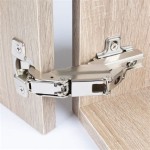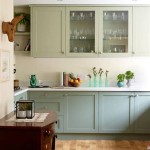Best Materials for Kitchen Cabinet Handles: A Comprehensive Guide
Selecting the right hardware for kitchen cabinets can significantly impact both the aesthetic appeal and functionality of the space. Kitchen cabinet handles, being one of the most frequently touched elements, require careful consideration in terms of material choice. The ideal material should balance durability, style, comfort, and cost-effectiveness. This article explores various materials commonly used for kitchen cabinet handles, outlining their properties, advantages, disadvantages, and applications to assist in making an informed decision.
Stainless Steel: Durability and Modern Appeal
Stainless steel is a popular material choice for kitchen cabinet handles due to its exceptional durability and resistance to corrosion. Its inherent strength allows it to withstand daily use and exposure to moisture and temperature fluctuations common in kitchen environments. The non-porous surface of stainless steel makes it hygienic and easy to clean, preventing the buildup of bacteria and grime. Furthermore, stainless steel is resistant to rust, ensuring its longevity even in humid conditions.
From an aesthetic standpoint, stainless steel offers a sleek and modern look that complements a variety of kitchen styles, particularly contemporary and minimalist designs. Its neutral tone blends well with different cabinet finishes and countertop materials. Stainless steel handles are available in various finishes, including brushed, polished, and satin, allowing for customization and coordination with other kitchen elements. The availability of different shapes and sizes further enhances the versatility of stainless steel handles.
However, stainless steel can be more expensive than some other materials. While the initial investment may be higher, the long lifespan and low maintenance requirements of stainless steel can offset the cost in the long run. Fingerprints can also be a visible issue on certain stainless steel finishes, requiring regular cleaning to maintain a pristine appearance. Despite these minor drawbacks, stainless steel remains a highly regarded material for kitchen cabinet handles due to its combination of strength, style, and hygiene.
Brass: Timeless Elegance and Antimicrobial Properties
Brass is an alloy composed of copper and zinc, known for its warm golden color and timeless elegance. It has been a favored material for decorative hardware for centuries, adding a touch of sophistication and refinement to kitchens. Brass handles are available in a range of finishes, including polished, antique, and satin, allowing for customization to match different design aesthetics. The natural luster of brass can enhance the visual appeal of kitchen cabinets, particularly in traditional, transitional, and vintage-inspired kitchens.
Beyond its aesthetic qualities, brass possesses inherent antimicrobial properties. Copper, a primary component of brass, naturally inhibits the growth of bacteria, viruses, and fungi. This makes brass handles a hygienic choice for kitchens, reducing the risk of contamination. The antimicrobial properties of brass are particularly beneficial in high-touch areas like cabinet handles, where germs can easily spread.
Brass is a durable material, but it is susceptible to tarnishing over time. Exposure to air and moisture can cause brass to oxidize, resulting in a darkened or dull appearance. Regular cleaning and polishing are necessary to maintain the original luster of brass handles. However, some homeowners appreciate the patina that develops on brass over time, adding character and a sense of history to the hardware. Solid brass handles are generally more expensive than those made from other materials, but the investment can be justified by their beauty, durability, and antimicrobial benefits.
Zinc Alloy: Affordability and Versatility
Zinc alloy is a cost-effective alternative to stainless steel and brass, offering a balance of durability and affordability. It is a versatile material that can be molded into various shapes and designs, allowing for a wide range of styles and finishes. Zinc alloy handles are commonly coated with different finishes, such as chrome, nickel, or bronze, to enhance their appearance and provide protection against corrosion.
Zinc alloy handles are relatively lightweight, making them easy to install and use. They are resistant to rust and corrosion, ensuring their longevity in humid environments. While not as strong as stainless steel or brass, zinc alloy handles are durable enough for everyday use in most kitchens. They are a good option for homeowners seeking a budget-friendly alternative without sacrificing quality and style.
However, zinc alloy handles may not be as resistant to scratches and dents as stainless steel or brass. The coating on zinc alloy handles can also wear off over time, exposing the base metal underneath. Regular cleaning and maintenance are necessary to keep zinc alloy handles in good condition. Despite these limitations, zinc alloy remains a popular choice for kitchen cabinet handles due to its affordability, versatility, and ease of installation.
Aluminum: Lightweight and Modern Aesthetics
Aluminum is a lightweight and corrosion-resistant metal that offers a modern and minimalist aesthetic. Aluminum handles are commonly used in contemporary and industrial-style kitchens. They are available in various finishes, including brushed, polished, and anodized, allowing for customization and coordination with other kitchen elements. The sleek and simple design of aluminum handles complements clean lines and minimalist cabinetry.
Aluminum is a durable material that can withstand daily use and exposure to moisture. It is resistant to rust and corrosion, making it suitable for kitchen environments. Aluminum handles are also relatively easy to clean and maintain. Their lightweight nature makes them easy to install and use.
While aluminum is durable, it is not as strong as stainless steel or brass. It is more susceptible to dents and scratches. Aluminum handles may also feel less substantial than handles made from heavier materials. However, the affordability and modern aesthetic of aluminum make it a popular choice for many homeowners and designers.
Ceramic: Delicate Beauty and Customization
Ceramic handles offer a unique and decorative touch to kitchen cabinets. They are available in a wide range of colors, patterns, and shapes, allowing for extensive customization and personalization. Ceramic handles are often hand-painted or decorated with intricate designs, adding an artistic flair to the kitchen. They are a good option for homeowners seeking to create a unique and personalized kitchen space.
Ceramic handles are typically more delicate than handles made from metal. They are susceptible to chipping and cracking if subjected to impact or excessive force. However, with proper care and handling, ceramic handles can last for many years. They are easy to clean and maintain, requiring only a damp cloth to wipe away dirt and grime.
Ceramic handles are often more expensive than handles made from other materials. They may also require special installation techniques to prevent damage. However, the beauty and customization options of ceramic handles make them a worthwhile investment for homeowners seeking to add a touch of artistry and elegance to their kitchens. They are particularly well-suited for cottagecore, farmhouse, and vintage-inspired kitchen designs.
Wood: Natural Warmth and Rustic Charm
Wood handles bring natural warmth and rustic charm to kitchen cabinets. They are available in various wood species, including maple, oak, cherry, and walnut, each offering a unique grain pattern and color tone. Wood handles can be stained or painted to match the cabinetry or create a contrasting effect. They are a good option for homeowners seeking to create a cozy and inviting kitchen space.
Wood handles are comfortable to grip and provide a tactile experience. They are less likely to become cold to the touch compared to metal handles. Wood handles can be shaped and carved into various designs, allowing for customization and personalization.
However, wood handles are susceptible to moisture damage and can warp or crack if exposed to excessive humidity. They require regular sealing and maintenance to protect them from moisture and prevent deterioration. Wood handles are also more susceptible to scratches and dents compared to metal handles. Despite these limitations, wood handles remain a popular choice for homeowners seeking to add a touch of natural beauty and rustic charm to their kitchens. They are particularly well-suited for farmhouse, traditional, and country-style kitchen designs.

5 Tips On Choosing The Right Kitchen Cabinet Hardware

Ultimate Guide For Cabinet Handles Rochehandle
Cabinet Hardware Guide Signature

Best Materials For Kitchen Cabinets Types And Uses Granite Countertops Pompano Beach Fl
:max_bytes(150000):strip_icc()/easy-steps-to-install-cabinet-hardware-1822225-07-0a31994a76dd450ba41b2ba2ba6e3d59.jpg?strip=all)
How To Select Cabinet Knobs And Pulls

7 Best Kitchen Cabinet Materials To Protect You From Poor Quality Horrors

The Best Knobs And Handles To Update Your Cupboards

Kitchen Cabinet Handles And Knobs Capricoast Blog

Ultimate Guide For Cabinet Handles Rochehandle

Brass Broe Chrome And Stainless Everything You Need To Know About Cabinet Hardware Airy Kitchens
Related Posts








